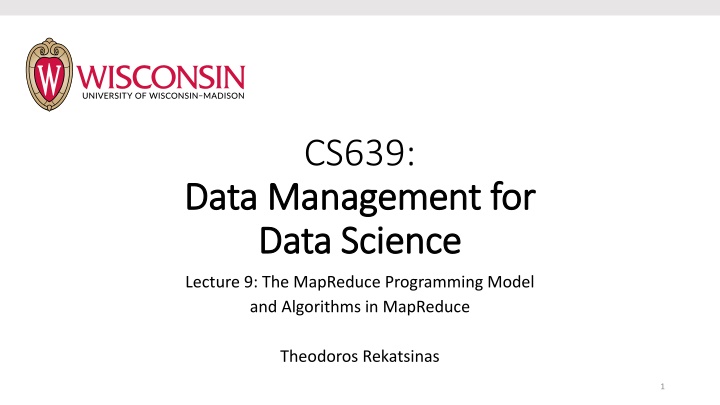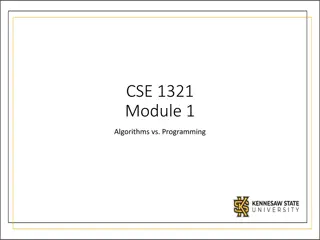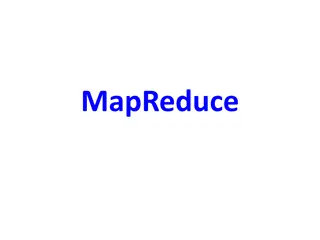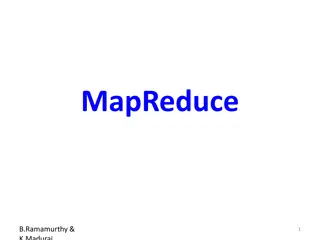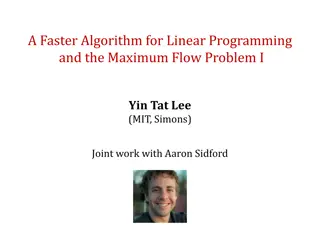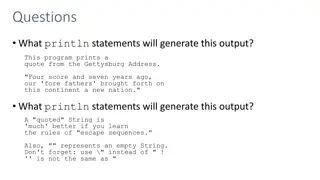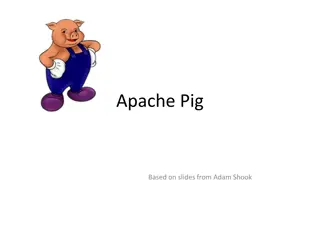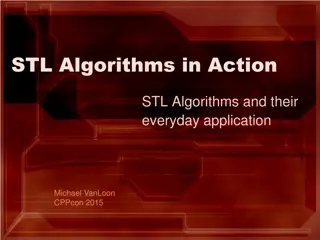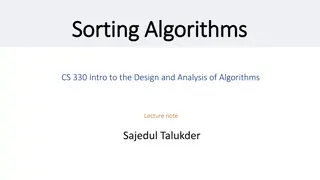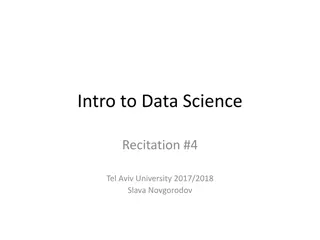The MapReduce Programming Model and Algorithms
MapReduce is a high-level programming model for large-scale data processing, comparable to RDBMS in its data model. This lecture delves into the MapReduce abstraction, programming model, and examples, highlighting its use in distributed algorithms and data storage. The data model in MapReduce revolves around files as bags of key-value pairs, forming the basis for map-reduce programs that process input and output key-value pairs in a distributed manner.
Download Presentation

Please find below an Image/Link to download the presentation.
The content on the website is provided AS IS for your information and personal use only. It may not be sold, licensed, or shared on other websites without obtaining consent from the author.If you encounter any issues during the download, it is possible that the publisher has removed the file from their server.
You are allowed to download the files provided on this website for personal or commercial use, subject to the condition that they are used lawfully. All files are the property of their respective owners.
The content on the website is provided AS IS for your information and personal use only. It may not be sold, licensed, or shared on other websites without obtaining consent from the author.
E N D
Presentation Transcript
CS639: Data Management for Data Management for Data Science Data Science Lecture 9: The MapReduce Programming Model and Algorithms in MapReduce Theodoros Rekatsinas 1
Logistics/Announcements Minor change on schedule Friday lecture covered by Paris Koutris We will skip Monday s lecture (I am in the bay area) 2
Todays Lecture 1. The MapReduce Abstraction 2. The MapReduce Programming Model 3. MapReduce Examples 3
The Map Reduce Abstraction for Distributed Algorithms Distributed Data Storage Map (Shuffle) Reduce
The Map Reduce Abstraction for Distributed Algorithms Distributed Data Storage map map map map map map Map (Shuffle) Reduce reduce reduce reduce reduce
The Map Reduce Abstraction for Distributed Algorithms Distributed Data Storage map map map map map map Map (Shuffle) Reduce reduce reduce reduce reduce
Map Reduce Shift (w1, 1) (w1, [1, 1, ]) (w1, 73) (docID=1, v1) (w2, 1) (w2, [1, 1, ]) (w2, 31) (w3, 1) (w3, [1, ]) (w3, 15) (w1, 1) (docID=2, v2) (w2, 1) (docID=3, v3) .
The Map Reduce Abstraction for Distributed Algorithms MapReduce is a high-level programming model and implementation for large-scale parallel data processing Like RDBMS adopt the the relational data model, MapReduce has a data model as well
MapReduces Data Model Files! A File is a bag of (key, value) pairs A bag is a multiset A map-reduce program: Input: a bag of (inputkey, value) pairs Output: a bag of (outputkey, value) pairs
User input All the user needs to define are the MAP and REDUCE functions Execute proceeds in multiple MAP REDUCE rounds MAP REDUCE = MAP phase followed REDUCE
MAP Phase Step 1: the MAP phase User provides a MAP-function: Input: (input key, value) Output: bag of (intermediate key, value) System applies the map function in parallel to all (input key, value) pairs in the input file
REDUCE Phase Step 2: the REDUCE phase User provides a REDUCE-function: Input: (intermediate key, bag of values) Output: (intermediate key, values) The system will group all pairs with the same intermediate key, and passes the bag of values to the REDUCE function
MapReduce Programming Model Input & Output: each a set of key/value pairs Programmer specifies two functions: map (in_key, in_value) -> list(out_key, intermediate_value) Processes input key/value pair reduce (out_key, list(intermediate_value)) -> (out_key, list(out_values)) Combines all intermediate values for a particular key Produces a set of merged output values (usually just one) Produces set of intermediate pairs
Example: what does the next program do? map(String input_key, String input_value): //input_key: document id //input_value: document bag of words for each word w in input_value: EmitIntermediate(w, 1); reduce(String intermediate_key, Iterator intermediate_values): //intermediate_key: word //intermediate_values: ???? result = 0; for each v in intermediate_values: result += v; EmitFinal(intermediate_key, result);
Example: what does the next program do? map(String input_key, String input_value): //input_key: document id //input_value: document bag of words word_count = {} for each word w in input_value: increase word_count[w] by one for each word w in word_count: EmitIntermediate(w, word_count[w]); reduce(String intermediate_key, Iterator intermediate_values): //intermediate_key: word //intermediate_values: ???? result = 0; for each v in intermediate_values: result += v; EmitFinal(intermediate_key, result);
Word length histogram How many big, medium, small, and tiny words are in a document? Big = 10+ letters Medium = 5..9 letters Small = 2..4 letters Tiny = 1 letter
Word length histogram Split the document into chunks and process each chunk on a different computer Chunk 2 Chunk 1
Word length histogram Chunk 2 Output (Big , 17) (Medium, 77) (Small, 107) (Tiny, 3) Chunk 1 Map Chunk 1 (204words)
Word length histogram Map task 1 Output (Big, 17) (Medium, 77) (Small, 107) (Tiny, 3) (Big, 17) (Big, 20) (Big, 37) (Medium, 77) (Medium, 71) (Medium, 148) Map task 2 (Small, 107) (Small, 93) (Small, 200) Output (Big, 20) (Medium, 71) (Small, 93) (Tiny, 6) (Tiny, 3) (Tiny, 6) (Tiny, 9)
Build an Inverted Index Input: Output: doc1, ( I love medium roast coffee ) doc2, ( I do not like coffee ) roast , (doc1) coffee , (doc1, doc2) doc3, ( This medium well steak is great ) doc4, ( I love steak ) medium , (doc1, doc3) steak , (doc3, do4)
Lets design the solution! Input: Output: doc1, ( I love medium roast coffee ) doc2, ( I do not like coffee ) doc3, ( This medium well steak is great ) roast , (doc1) coffee , (doc1, doc2) medium , (doc1, doc3) doc4, ( I love steak ) steak , (doc3, do4)
